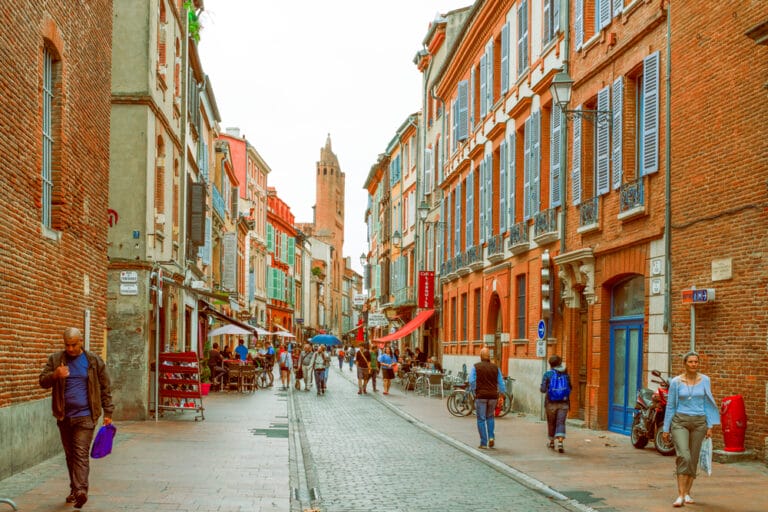How to Say Nice to Meet You in French
Bonjour! Are you ready to add a touch of French elegance to your social interactions? Saying ‘Nice to meet you’ in French is not only a great way to impress your new francophone acquaintances, but it also adds a charming flair to your conversations.
In this guide, we’ll explore the different ways to express Nice to meet you in French and delve into the cultural nuances that accompany these phrases.
From the formal “Enchanté(e)” to the more casual “Ravi(e) de te rencontrer,” we’ll equip you with the perfect expressions to make a lasting impression. Whether you’re planning a trip to France, meeting French-speaking colleagues, or simply want to expand your linguistic horizons, this guide will help you navigate the intricacies of French greetings with ease.
So, let’s dive into the world of French etiquette and language, and discover how to say ‘Nice to meet you’ in French like a true bon vivant!

The Importance of Greetings in French Culture
In French culture, greetings play a vital role in establishing social connections and demonstrating respect. The way you greet someone sets the tone for the entire interaction, so it’s important to get it right. French greetings are often accompanied by a handshake, a kiss on the cheek, or both, depending on the level of familiarity with the person you’re greeting.
This physical contact reflects the warmth and intimacy that the French value in their social interactions. Additionally, using proper greetings shows that you understand and appreciate French culture, which goes a long way in making a positive impression. Remember, the French take their greetings seriously, so mastering the art of saying ‘Nice to meet you’ in French will not only make you more likeable but also help you navigate social situations with ease.
French greetings are not limited to just ‘Nice to meet you.’ There are various expressions for different times of the day, different levels of formality, and even different regions of France. Let’s explore the basics of French greetings to set the foundation for expressing ‘Nice to meet you’ in the most appropriate way.
Basic French Greetings
In French, greetings vary depending on the time of day. Here are some common greetings you can use to start a conversation:
1. Bonjour (Good day) – This is the most common and versatile greeting that can be used at any time of the day. It’s a safe choice in most situations and is considered polite and friendly.
2. Bonsoir (Good evening) – This greeting is used when meeting someone in the evening or after dark. It’s a more formal alternative to “Bonjour” and is appropriate when you want to show respect.
3. Salut (Hi/Hello) – This is an informal greeting commonly used among friends and acquaintances. It’s less formal than “Bonjour” and “Bonsoir” and is suitable for casual situations.
4. Coucou (Hey) – This is an even more casual and friendly greeting, often used among close friends and family members. It’s similar to “Salut” but carries a slightly warmer tone.
Now that we have covered the basics, let’s focus on the specific phrase ‘Nice to meet you’ and its equivalents in French.
How to Say Nice to Meet You in French
1. Enchanté(e) – This is the most formal way to say ‘Nice to meet you’ in French. It is used in formal settings or when meeting someone for the first time. The word “enchanté(e)” translates to “enchanted” or “delighted,” and it expresses your pleasure in meeting the person.
2. Ravi(e) de vous rencontrer – This phrase translates to “Delighted to meet you” and is slightly less formal than “Enchanté(e).” It can be used in both formal and informal situations, depending on the level of familiarity with the person you’re greeting.
3. Heureux(se) de faire votre connaissance – This expression is a bit more formal and translates to “Happy to make your acquaintance.” It conveys a sense of respect and is often used in professional settings or when meeting someone of higher status.
4. Ravi(e) de te rencontrer – This is the casual equivalent of “Ravi(e) de vous rencontrer” and is used when greeting friends, peers, or people of the same age group. It creates a friendly and approachable atmosphere, perfect for informal encounters.
Remember to match the level of formality with the appropriate greeting. Using the wrong expression can be seen as disrespectful or overly familiar, so it’s essential to choose the right phrase for the occasion. Now that you know how to say ‘Nice to meet you’ in French, let’s explore different ways to make a lasting impression in French culture.
How to Say Very nice to meet you in French
Very Nice to Meet You in French is “ravi de vous rencontrer”
Different Ways to Make a Lasting Impression in French Culture
In French culture, making a lasting impression goes beyond just the words you use. It involves a combination of verbal and non-verbal communication, as well as an understanding of cultural nuances. Here are some tips to help you leave a positive and lasting impression when greeting someone in French:
1. Maintain eye contact – When greeting someone in French, maintaining eye contact shows that you are engaged and interested in the interaction. It conveys sincerity and respect.
2. Use appropriate body language – The French value physical contact, so a handshake or a kiss on the cheek is often expected when greeting someone. However, it’s important to gauge the level of familiarity before initiating any physical contact. If unsure, follow the lead of the person you’re greeting.
3. Smile genuinely – A warm and genuine smile is universally appreciated and can help establish a friendly connection. It shows that you are approachable and open to conversation.
4. Pay attention to personal space – The French value their personal space, so it’s important to respect boundaries when greeting someone. Avoid standing too close or invading their personal space, especially with people you have just met.
By combining these non-verbal cues with the appropriate verbal expressions, you’ll be able to make a lasting impression that reflects your understanding and appreciation of French culture. However, it’s crucial to be aware of the cultural nuances that accompany French greetings.
Cultural Nuances to Be Aware of When Greeting Someone in French
French greetings are deeply rooted in cultural norms and traditions. Being aware of these nuances will help you navigate social situations with ease and avoid any unintentional faux pas. Here are some cultural nuances to keep in mind:
1. Kiss on the cheek – In France, it is common to greet someone with a kiss on each cheek, starting with the left cheek. The number of kisses may vary depending on the region, so it’s best to follow the lead of the person you’re greeting. If unsure, a handshake is always a safe option.
2. Formality and hierarchy – The French have a strong sense of formality and respect for hierarchy. When greeting someone of higher status or older age, it’s important to use more formal language and show deference.
3. Addressing someone – In French, it is customary to address someone by their title or last name until they invite you to use their first name. This applies to both formal and informal settings. If unsure, it’s best to err on the side of formality and wait for the person to indicate how they would like to be addressed.
4. Use of titles – In professional settings, it is common to address someone by their title, such as “Monsieur” or “Madame,” followed by their last name. This shows respect and professionalism.
By being mindful of these cultural nuances, you’ll be able to navigate French greetings with confidence and show your respect for French traditions. However, it’s important to avoid common mistakes that may unintentionally offend or give the wrong impression.
Common Mistakes to Avoid When Greeting Someone in French
When it comes to French greetings, there are a few common mistakes that non-native speakers often make. By being aware of these mistakes, you can avoid them and ensure a smooth and respectful interaction. Here are some common mistakes to avoid:
1. Mispronunciation – French pronunciation can be challenging, but making an effort to pronounce greetings correctly shows respect and will be appreciated by native speakers. Practice the pronunciation of common greetings to avoid any embarrassing slip-ups.
2. Using informal language in formal situations – Using casual expressions like “Salut” or “Coucou” in formal settings can be seen as disrespectful or unprofessional. It’s important to match the level of formality with the appropriate greeting.
3. Ignoring non-verbal cues – Non-verbal communication is just as important as the words you use. Ignoring physical contact or failing to maintain eye contact can be perceived as aloof or disinterested. Pay attention to non-verbal cues and respond accordingly.
4. Overusing greetings – While greetings are important in French culture, overusing them can be seen as insincere or excessive. Use greetings appropriately and avoid repeating them excessively in a single conversation.
By avoiding these common mistakes, you’ll be able to navigate French greetings with confidence and make a positive impression. Now, let’s move on to some practice exercises to help you improve your French greetings.
Practice Exercises to Improve Your French Greetings
1. Role-playing – Practice different greetings in various scenarios, such as meeting a friend, a colleague, or a stranger. This will help you become more comfortable with different expressions and levels of formality.
2. Language exchange – Find a language exchange partner or join a language learning group where you can practice greetings with native French speakers. This will give you the opportunity to receive feedback and improve your pronunciation.
3. Watch French movies or TV shows – Pay attention to how greetings are used in different social situations. This will help you understand the context and appropriate expressions for each scenario.
4. Use greetings in daily life – Incorporate French greetings into your daily conversations, even outside of French-speaking environments. This will help you become more comfortable and natural with the language.
By practicing these exercises, you’ll be able to improve your French greetings and confidently engage in conversations with native speakers. However, if you’re looking for more resources to further enhance your knowledge of French greetings and expressions, there are plenty available.
Resources for Further Learning French Greetings and Expressions
1. Language learning apps – Many language learning apps, such as Duolingo, Babbel, and Rosetta Stone, offer comprehensive courses that cover greetings and other essential language skills. These apps provide interactive exercises and quizzes to help you practice and reinforce your learning.
2. Language learning websites – Websites like FluentU, FrenchPod101, and BBC Languages have extensive resources for learning French greetings and expressions. They offer videos, audio lessons, and interactive exercises to cater to different learning styles.
3. Language exchange platforms – Websites and apps like Tandem, HelloTalk, and Italki connect language learners with native speakers for language exchanges. These platforms provide an opportunity to practice greetings and receive feedback from native speakers.
4. French language courses – Enrolling in a formal French language course, either online or in person, can provide a structured learning environment and personalized guidance. Many language schools and universities offer French courses for learners of all levels.
By utilizing these resources, you’ll be able to deepen your understanding of French greetings and expand your language skills. With consistent practice and exposure to the language, you’ll soon be confidently saying ‘Nice to meet you’ in French like a true bon vivant!
Can You Teach Me More French Greetings?
Sure, I can definitely teach you more French greetings! There are many beautiful french good morning expressions such as “bonjour” and “salut.” Learning these phrases will make it easier for you to communicate with French speakers and show that you respect their culture.
Conclusion
Mastering the art of saying ‘Nice to meet you’ in French is not only a linguistic skill but also a way to embrace French culture and make lasting impressions. By understanding the importance of greetings in French culture, learning the appropriate expressions, and being aware of the cultural nuances, you’ll be able to navigate social interactions with ease and confidence.
Remember to practice and seek out additional resources to enhance your language skills. So, whether you’re planning a trip to France, meeting French-speaking colleagues, or simply want to expand your linguistic horizons, embrace the beauty of French greetings and make a lasting impression like a true bon vivant! Au revoir et à bientôt!
Planning your French Trip then you can get the complete guide about France here.
Get your Notion Travel Planner Template!
Embark on your next adventure with the Wanderlust Planner, the ultimate Notion Travel Planner Template. Organize your wanderlust-fueled dreams and turn them into unforgettable journeys. Whether you’re a seasoned globetrotter or a newbie explorer, this template has you covered.






